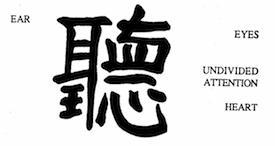
It may seem strange that in English we have just one word for the act of listening, sometimes used as a verb with ‘to’ and sometimes used without or at times with an exclamation mark when we need to get the attention of our listeners – Listen!
This is also true of many languages, there is just the one word – listen, with a distinction made between the passive ‘action’ of hearing, which is an integral part of listening (or at least should be!) or the capability to do as such, and the more active, listening.
In terms of language, listening is perhaps the most important skills and notably one of the most difficult to master, especially when a foreign language is usually made up of ‘foreign’ sounds that our ears are just not able to hear, without extensive training.
So how can we hope to be able to listen with the end objective being to understand, when we can’t hear half of what is said?
How many of us, as children, have heard the remark, “You should learn to listen”?
Well, OK, but how?
Even in our own native languages we are never taught How to listen, not in the same way as we are taught to read, write, and to some extent, how to speak.
We are all well trained in the act of partial listening, as an attempt to multitask and juggle all that life throws at us – half listening to the Radio/TV whilst conversing, listening in on the conversation at the next table in the restaurant etc.
This has led to the incredible ability to blank-out what we don’t want to listen to – yes, we all do it – then pick up on keywords, or key ideas and develop them as we want – effectively managing the conversations of others.
One of the most challenging activities that people have is actually listening to others, not speaking and not giving opinions but fully listening – and this is mostly due to the best intentions that we all have to help the speaker get their message across effectively, whilst unintentionally distorting the communication.
How often have you wanted to state loudly and clearly “NO, YOU DON’T!” when someone tells you that they know exactly how you feel after you have communicated your thoughts / feelings about something.
Consider, how many times that others have had the desire to say the same to you…
We often help underpin this by stating such untruths as “I know exactly what you are saying” or “I hear what you are saying” whereas in most cases both are so starkly untrue that they are almost pleonasms.
Listening is perhaps the hardest of the soft skills to master as it takes a paradigm shift in attitude and to how we approach listening – it is just not a passive absorption or transfer of information from speaker to listener – that would be too easy and would always result in effective communication and this doesn’t always occur.
Listening is part of an unwritten contract that puts a 50/50 responsibility for the message on both speaker and listener.
This can be understood through one of the presuppositions of NLP (Neuro Linguistic Programming), which states that the meaning of our communication is the response that it elicits – meaning that an end-to-end communication scenario is a lot more complex than it may appear at first.
Well that is half of the story and we wont go into NLP principles here, but it does illustrate an important point in the communication game – that of responsibility for the communication process, and more implicitly, for the message that is understood.
So, as we have seen there is only the one word for ‘listen’ in the English language.The same word is represented by the Chinese kanji character, “Ting” “Ting” is, in turn, made up of the following characters:

This is really quite striking in as much as, the differences between our conception and understanding of the word “listen” as being solely an action undertaken by the ears, and that of “Ting” show a contrast of understanding.
The integration of the eyes, the ears, undivided attention and the heart captures the true essence of listening or at least that of effective listening, without the egocentricities that are often attached to listening.
Think about this the next time you are listening to somebody, or when someone is listening to you:
- Can you detect times when you don’t give or get undivided attention?
- Are there times when eye contact is lost or diffused in such a way that you are not listening at 100% (or your listener is drifting away from you)?
- Can you tell when people are thinking about what they are going to say, before they have fully listened to you? Do you do this when listening to somebody?
Now, this, as we see it, is from a Eurocentric / western understanding, in terms of the similarities in our cultures.
What do you think happens when we interact with people from other cultures, especially cultures where prolonged eye-contact is almost culturally taboo?
Some cultures will have difficulties adapting to strategies of paraphrasing and understanding-checking, that is a feature of active listening skills.
How do you deal with that?
I don’t intend answering these questions in this post but it is something that I would like to explore in another posting at a later date as cross-cultural communication is an area that particularly interests me.
Active listening skills are an essential life and soft-skill that will, once mastered, help in the following areas:
- Conflict resolution
- Team-building
- Leadership
- Negotiations
- Meeting management
- Recruitment
- Feedback
- Coaching
- Mentoring
- Counselling
- etc.
When you are in a listening situation next, try using the 4 elements of the “Ting” character to help build and develop your listening skills – you will be surprised how much it can help you and your listener – it is also worth noting that when you use active listening skills – the compliment is often returned as it is a reciprocal process.

© 2012, ©Active Consultants 2011. All rights reserved. Copying in part or in entirety only permitted by written consent

Original content here is published under these license terms: X
License Type:Commercial
License Summary:You may read the original content in the context in which it is published (at this web address). You may make other uses of the content only with the written permission of the author on payment of a fee.
Republished by Blog Post Promoter

